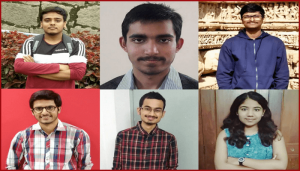Since 2017, a nationwide hackathon has enabled lakhs of students to pitch in and innovatively solve some everyday pressing problems faced by governments, industries, and NGOs with the help of technology. This year, a IIITH team of students built an advanced library software solution for a college in the Andamans winning them a prize in what was possibly the world’s biggest virtual hackathon.
With over 240 problem statements across a gamut of themes from smart communication, and healthcare devices, agriculture and rural development, to smart vehicles, robotics and drones, to waste management, and miscellaneous technology ideas in sectors like hospitality, entertainment and tourism, the Smart India Hackathon which was initiated in 2017 is an innovation opportunity for talented youngsters pan-India. The way it works is that organizations seek solutions to problems (put forth in the form of problem statements) they’ve been facing. To illustrate, this year in the hardware category, the National Mission for Clean Ganga along with the Ministry of Jal Shakti sought an artificial intelligence-enabled robotic trash boat to drive & harvest floating trash from urban drains. It saw 66 submissions from student teams proposing various solutions. Similarly in the software category of the hackathon, for instance, a solution for Alzheimer’s Disease detection in the form of a mobile game was sought by Yamaha Motor Solution India Pvt Ltd which saw 77 submitted ideas. The IIITH team chose an open-ended problem statement of ‘Library Software for Andaman College’ proposed by Dr BR Ambedkar Institute of Technology in the Smart Education domain. It saw 49 idea submissions.
Inclusion Of The Best
Individual colleges are first required to conduct an internal hackathon based on which the best teams are shortlisted for entry into the national-level competition. Each team comprises of 6 students with one mandatory female participant. With hackathons being male-dominated domains both visibly as well as anecdotally, it is the Centre’s bid to make such competitions more inclusive. The best solution to each problem statement is adjudged a winner by a panel of evaluators that oversees progress and mentors the finalists over the 3-day Grand Finale which concluded on 4 August 2020.
Library Management System
Staying true to its name, IIITH Team Occam’s Razor – which means that the simplest explanation is usually the best one – comprising of Gaurang Tandon (Team Leader), Akshat Goyal, Avani Gupta, Kanish Anand, Arpan Dasgupta, and Animesh Sinha opted to create a seemingly simple library management system for a college in the Andamans. While the simplest of such software systems helps to keep the records of transactions of the books available in a library, the team came up with sophisticated ideas to enhance the basic framework. “Auto-tagging of books the minute they enter the library is not that hard. We wanted the system to be more efficient and seamless though,” says Gaurang. Plus, they wanted to make it more user-friendly, from the (book) borrower’s perspective. “Apart from having a search functionality, traditional Library Management Systems are not constructed from this point of view. Hence we thought of adding a recommender that will suggest books based on the user’s reading patterns,” he says. In addition to this, they integrated a chatbot into the system through which basic functionality such as searching for, borrowing and returning books, as well as finding book recommendations could be executed through the bot. All of this was packaged into a cross-platform app with the help of Google’s Flutter framework. They then trained a Machine Learning model for auto-tagging books just by scanning their ISBN barcodes as efficiently as possible. “The idea was to use the app on existing smartphones and scan the codes via the phone cameras in lieu of additional hardware such as ISBN scanners,” explains Gaurang. Finally, to provide data analytics such as the number, type of books issued, etc under various categories, the team also built a server where the administrator or librarian could login and gain access to such reports at a glance.

Online Edition
Due to the ongoing pandemic, the coding fiesta that was previously conducted at various nodal centres across India transitioned into the online format. The IIITH team which was spread out across Punjab, Haryana, Raipur, Ranchi, Baroda and Lucknow relied heavily on Microsoft Teams to discuss their ideas. Speaking of how they communicated, Gaurang says that it was challenging to tell if everyone was onboard with the idea or not. “When you’re physically present in one room, it’s easy to tell if they’ve grasped the idea or if they’re not ok with the idea due to the presence of physical cues. Through a voice call, it’s harder to get the flow going. And the process also becomes slower because you’re trying to get everyone on the same page,” he says. Avani Gupta who was the female presence on Occam’s Razor says that initially she was unable to understand why women needed reservations of any kind. “This competition made me understand the rationale behind it to some extent. I think the main drawback women in the tech field have is that, by virtue of being the minority, we don’t have too many options for forming teams in such competitions. This initiative may have helped so many girls all over India,” she says.
Making It A Reality
The library software solution which was built from scratch runs into thousands of lines of code. “All of it works remarkably well for the time we invested in it and we learned a lot from it,” says Gaurang. Expressing optimism of a real life implementation, he says it would be nice if their solution could be used by people in a real library. Current library systems only look at the perspective of the librarians or administrative staffers, ignoring the borrowers. With their solution that looks at both the view points, it would be a great opportunity and incentive to work with Dr. B R Ambedkar Institute of Technology that provided the problem statement, says the team.


